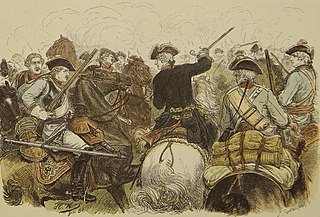 W
WThe 1740 to 1748 War of the Austrian Succession was the last Great Power conflict with the Bourbon-Habsburg dynastic conflict at its heart, and marked the rise of Prussia as a major power. Related conflicts include King George's War, the War of Jenkins' Ear, the First Carnatic War, as well as the First and Second Silesian Wars.
 W
WThe First Carnatic War (1746–1748) was the Indian theatre of the War of the Austrian Succession and the first of a series of Carnatic Wars that established early British dominance on the east coast of the Indian subcontinent. In this conflict the British and French East India Companies vied with each other on land for control of their respective trading posts at Madras, Pondicherry, and Cuddalore, while naval forces of France and Britain engaged each other off the coast. The war set the stage for the rapid growth of French hegemony in southern India under the command of French Governor-General Joseph François Dupleix in the Second Carnatic War.
 W
WCastellane is a commune in the Alpes-de-Haute-Provence department in southeastern France. With about 1,600 inhabitants, Castellane has the distinction of being the least-populated sub-prefecture of France.
 W
WThe Congress of Breda, also known as the Breda peace talks, were a series of bilateral negotiations between Great Britain and France, held in the Dutch city of Breda from 1746 and 1748. The discussions led to the agreement of terms that later became the basis of the 1748 Treaty of Aix-la-Chapelle.
 W
WThe First Silesian War was a war between Prussia and Austria that lasted from 1740 to 1742 and resulted in Prussia's seizing most of the region of Silesia from Austria. The war was fought mainly in Silesia, Moravia and Bohemia and formed one theatre of the wider War of the Austrian Succession. It was the first of three Silesian Wars fought between Frederick the Great's Prussia and Maria Theresa's Austria in the mid-18th century, all three of which ended in Prussian control of Silesia.
 W
WKing George's War (1744–1748) is the name given to the military operations in North America that formed part of the War of the Austrian Succession (1740–1748). It was the third of the four French and Indian Wars. It took place primarily in the British provinces of New York, Massachusetts Bay, New Hampshire, and Nova Scotia. Its most significant action was an expedition organized by Massachusetts Governor William Shirley that besieged and ultimately captured the French fortress of Louisbourg, on Cape Breton Island in Nova Scotia, in 1745. In French, it is known as the Troisième Guerre Intercoloniale or Third Intercolonial War.
 W
WThe Music for the Royal Fireworks is a suite in D major for wind instruments composed by George Frideric Handel in 1749 under contract of George II of Great Britain for the fireworks in London's Green Park on 27 April 1749. The music celebrates the end of the War of the Austrian Succession and the signing of the Treaty of Aix-la-Chapelle (Aachen) in 1748. The work was very popular when first performed and following Handel’s death. Mozart called the work a “spectacle of English pride and joy.”
 W
WThe Second Silesian War was a war between Prussia and Austria that lasted from 1744 to 1745 and confirmed Prussia's control of the region of Silesia. The war was fought mainly in Silesia, Bohemia, and Upper Saxony and formed one theatre of the wider War of the Austrian Succession. It was the second of three Silesian Wars fought between Frederick the Great's Prussia and Maria Theresa's Austria in the mid-18th century, all three of which ended in Prussian control of Silesia.
 W
WThe Silesian Wars were three wars fought in the mid-18th century between Prussia and Austria for control of the Central European region of Silesia. The First (1740–1742) and Second (1744–1745) Silesian Wars formed parts of the wider War of the Austrian Succession, in which Prussia acted as one member of a coalition seeking territorial gain at Austria's expense. The Third Silesian War (1756–1763) was one theatre of the global Seven Years' War, in which Austria in turn led a coalition of powers aiming to seize Prussian territory.
 W
WThe Treaty of Madrid, also known as the Treaty of Aquisgran, was a commercial treaty between Britain and Spain, formally signed on 5 October 1750 in Madrid.
 W
WTrenck's Pandurs were a light infantry unit of the Habsburg Monarchy, raised by Baron Franz von der Trenck under a charter issued by Maria Theresa of Austria in 1741. The unit was largely composed of volunteers from the Kingdom of Slavonia and Slavonian Military Frontier, and named after security guards otherwise employed to maintain public order. The Pandurs were presented to the empress in May 1741—with the unit's military band—earning them a claim of pioneering martial music in Europe. The Pandurs did not use uniforms and had an overall oriental/Ottoman appearance. The original organization of the unit was retained until 1745, when it transformed into a regiment. Trenck was relieved of command in 1746 and imprisoned in Spielberg Castle, where he died in 1749. The unit ultimately transformed into the 53rd Infantry Regiment, headquartered in Zagreb, until it was disbanded in 1919. The regiment's commemorative medals bear Trenck's image wearing Pandur attire.
 W
WThe War of Jenkins' Ear was a conflict between Britain and Spain lasting from 1739 to 1748, mainly in New Granada and among the West Indies of the Caribbean Sea, with major operations largely ended by 1742. Its name, coined by British historian Thomas Carlyle in 1858, refers to Robert Jenkins, a captain of a British merchant ship, who suffered having his ear severed when Spanish sailors boarded his ship at a time of peace. There is no evidence that supports the stories that the severed ear was exhibited before the British Parliament.